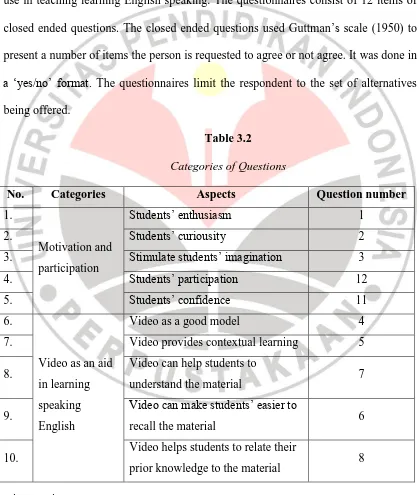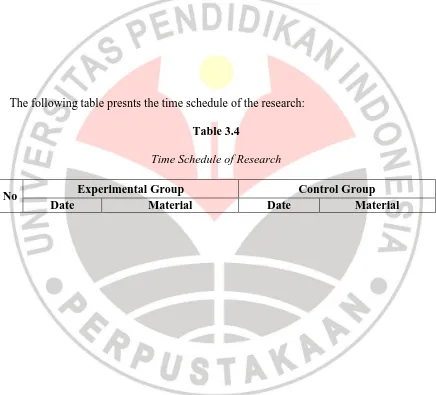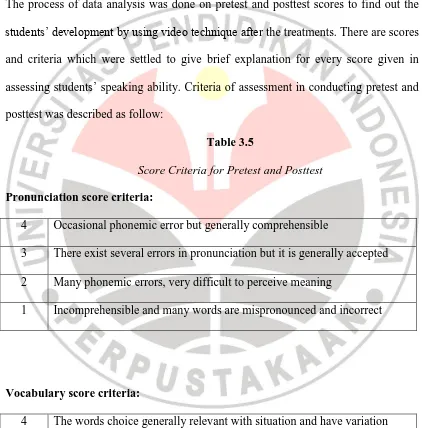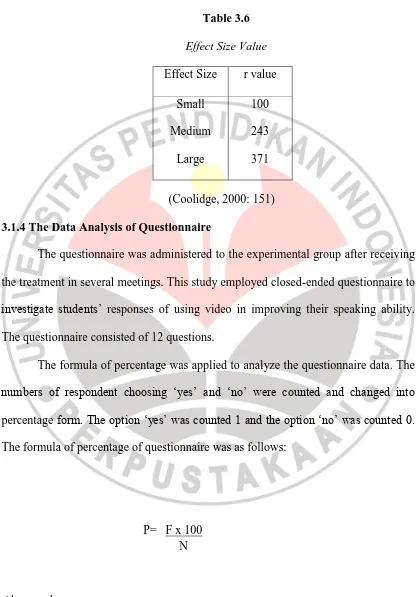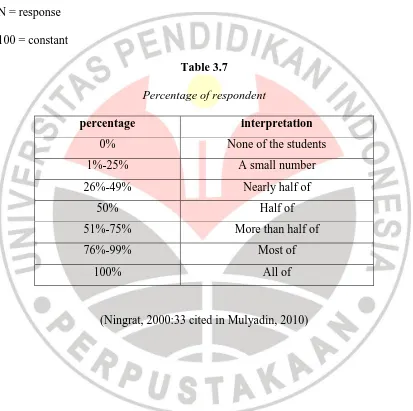THE USE OF VIDEOS
TO IMPROVE STUDENTS’ SPEAKING
ABILITY
(A Quasi-Experimental Study to the Seventh Grade Students of Junior High School in Bandung)
A Research Paper
Submitted to the Department of English education of FPBS UPI as a Partial Fulfillment of the Requirements for Sarjana Pendidikan Degree
By
Shinta Puspita S.R 0606541
English Education Department
Faculty of Language and Arts Education
THE USE OF VIDEOS TO IMPROVE
STUDENTS’ SPEAKING ABILITY
(A Quasi-Experimental Study to the
Seventh Grade Students of Junior High
School in Bandung)
Oleh
Shinta Puspita Sari Rahayu
Sebuah skripsi yang diajukan untuk memenuhi salah satu syarat memperoleh gelar Sarjana pada Fakultas Pendidikan Bahasa dan Seni
© Shinta Puspita Sari Rahayu 2013 Universitas Pendidikan Indonesia
Juli 2013
PAGE OF APPROVAL
THE USE OF VIDEOS TO IMPROVE STUDENTS’ SPEAKING ABILITY (A Quasi-Experimental Study to the Seventh Grade Students of Junior High School in
Bandung)
By
Shinta Puspita S.R
0606541
Approved by
Main Supervisor
Prof. Dr. H Didi Suherdi, M.Ed.
NIP. 196211011987121001
Co-Supervisor
Ika Lestari Damayanti, M.A.
NIP. 197709192001122001
Head of English Education Department
Faculty of Language and Arts Education
Indonesia University of Education
Prof. Dr. H Didi Suherdi, M.Ed.
ABSTRACT
This study is a quasi-experimental study which examines the effectiveness of video use in teaching learning process to improve students’ speaking ability. In addition, it tries to find out students’ responses toward the use of video in teaching learning speaking. The study was conducted at one of Junior High School in Bandung with 78 sample students of seventh graders.
The study employed a non-equivalent control group design, both experimental and control groups were given pretest and post test after the experimental group was treated by using video technique proposes by Baxter (1994), Stempleski (1990, cited in Richard and Renandya, 2007), Stempleski and Tomalin (2010) for six meetings. The data obtained from pretest and posttest then were analyzed using t-test SPSS version 17.0. The findings indicated that the use of video was effective in improving students’ speaking ability. In addition, the questionnaire was only given to the experimental group. The questionnaire consisted 12 closed-ended questions. They were analized by percentage based on Ningrat (2000, cited in Mulyadin, 2003). The findings revealed that most of students gave positive responses since video could help them in their learning process. As the result, students’ participation arose and their speaking ability improved.
In reference to the result of this study, it can be conclude that the use of video is recommended to be applied in teaching learning speaking to the junior high school students. Moreover, the teachers who are interested in carry out the video in teaching learning speaking need to have well preparation such as checking the equipment, organizing the class, and arranging good lesson plan.
ABSTRAK
Penelitian ini adalah penelitian kuasi eksperimental yang menguji keefektifan dari penggunaan video dalam proses belajar mengajar untuk meningkatkan kemampuan speaking siswa. Lebih lanjut lagi, penelitian ini mencoba mencari tau respon siswa terhadap pengguanaan video dalam proses belajar mengajar
speaking. Penelitian ini dilakukan di sebuah sekolah menengah pertama di
bandung dengan menggunakan 78 siswa kelas tujuh sebagai sampel penelitian. Penelitian ini menggunakan sebuah desain non-ekuivalen grup kontrol, dimana grup eksperimantal dan grup kontrol diberikan pretest dan posttest setelah grup ekperimental mendapatkan perlakuan (treatment) menggunakan teknik video yang digagas oleh Baxter (1994), ), Stempleski (1990, tercantum di Richard and Renandya, 2007), Stempleski and Tomalin (2010) selama enam pertemuan. Data yang diperoleh melalui pretest dan posttest kemudian dianalisis menggunakan
t-test SPSS versi 17.0. Hasil penemuan mengindikasikan bahwa pengguanaan
video terbukti efektif dalam meningkatkan kemampuan speaking siswa. Lebih lanjut lagi, grup eksperimental diberikan kuisioner. Kuisioner tersebut terdiri dari 12 pertanyaan tertutup yang kemudian dianalisis menggunakan persentase yang digagas oleh Ningrat (2000, tercantum di Mulyadin, 2003). Hasil penemuan dari kuisioner menunjukkan bahwa sebagian besar siswa memberikan respon positif dikarenakan video dapat membantu mereka dalam proses belajar. Sehingga, partisipasi siswa meningkat begitu pula dengan kemampuan speaking mereka. Dengan mengacu kepada hasil dari penelitian ini, maka dapat disimpulkan bahwa penggunaan video dianjurkan untuk dilakukan dalam proses belajar mengajar
speaking kepada siswa sekolah menengah pertama. Tambahan lagi, untuk guru
yang tertarik menggunakan video dalam proses belajar mengajar speaking perlu melakukan persiapan yang baik seperti mengecek peralatan, mengatur kelas, dan menyusun RPP yang baik.
TABLE OF CONTENTS
PAGE OF APPROVAL ... i
STATEMENT OF AUTHORIZATION ... ii
PREFACE ... iii
ACKNOWLEDGMENTS ... iv
ABSTRACT ... v
TABLE OF CONTENTS ... vi
LIST OF TABLES ... ix
CHAPTER I INTRODUCTION ... 1
1.1. Background ... 1
1.2. Research Questions ... 3
1.3. Significance of the Study ... 3
1.4. The Aim of the Study ... 4
1.5. Research Methodology... 4
1.5.1. Research Design ... 5
1.5.2. Population and Sample ... 6
1.5.3. Data Collection ... 6
1.5.4. Hypothesis ... 6
1.6. Clarification of Term ... 7
1.7. Organization of the paper ... 8
2.2. The Role of Video in Teaching Speaking ... 12
2.2. Techniques and Strategies of Teaching Speaking ... 13
2.2. Teaching Learning Speaking through Video ... 15
2.3. Teaching Speaking by Audio-lingual Method ... 17
CHAPTER III RESEARCH METHODOLOGY ... 19
3.1. Research Design ... 19
3.1.1. Data Collection ... 20
3.1.1.1. Population and Sample ... 21
3.1.1.2. Research Instruments ... 21
3.1.2. Research Procedure ... 23
3.1.2.1. Organizing Teaching Procedure ... 23
3.1.2.2. Conducting Treatment ... 24
3.1.2.2. Administering Pre-test and Post-test ... 27
3.1.3. Data Analysis ... 28
3.1.3.1. Data Analysis on Pre-test ... 29
3.1.3.1.1. Normal Distribution Test ... 29
3.1.3.1.2. The Homogeneity of Variance Test ... 30
3.1.3.1.2. The Independent T-test ... 31
3.1.3.2. Data Analysis on Post-test ... 32
3.1.3.3. The Calculation of Effect Size ... 32
3.1.3.1. Data Analysis of Questionnaire... 33
CHAPTER IV FINDINGS AND DISCUSSION ... 35
4.1.1. The Pre-test Result ... 35
4.1.1.1. Normal Distribution Test ... 36
4.1.1.2. The Homogeneity of Variance Test ... 37
4.1.1.3. The Independent T-test ... 37
4.1.2. The Post-test Result ... 37
4.1.2.1. Normal Distribution Test ... 38
4.1.2.2. The Homogeneity of Variance Test ... 39
4.1.2.3. The Independent T-test ... 39
4.1.2.4. The Calculation of Effect Size ... 40
4.1.2.5. The Dependent T-test ... 40
4.1.3 The pretest and Posttest Result. ... 41
4.1.4. The Analysis of Questionnaire ... 44
4.2. Discussion ... 48
CHAPTER V CONCLUSION AND SUGGESTIONS ... 52
5.1. Conclusions ... 52
5.2. Suggestions ... 53
REFERENCES ... 54
CHAPTER I
INTRODUCTION
This chapter presents an overview of this study. It consists of background, research questions, aim of the study, significance of the study, research methodology, clarification of terms, and organization of paper.
1.1 Background
Speaking English as a foreign language is perceived as a difficult skill to be taught and learned since the learners have to think and speak at the same time to present their idea orally. They might also encounter some problems that obstruct them to be good English speakers. The problems include lack of self confidence, fear of making mistake, and lack of vocabularies and grammar. Thornbury (2006) states that essentially, learner-speaker faces two main areas of difficulties, namely knowledge factors and skill factors that affect other factors such as lack confidence or self consciousness.
students’ motivation in learning speaking English, provide appropriate aids, and
create fun environment to learn English.
Therefore, media are needed to accommodate students to have those conditions. One of the suitable media for teaching speaking is video. A variety of videos can be used for English language teaching in the class such as TV program, advertisement, music clip, and so on.
As a medium, video can help teachers deliver the materials and convey the message, and it also motivates students as well. Video delivers material in context, particularly in speaking, the language is delivered more lively since students can hear the language and watch the situation of the language use at the same time. The visual descriptions provided by the video give some clues to convey the message to the students and make the students easier to understand the materials. The visual clues include situation, environment, gesture, facial expression, and so forth. Canning-Wilson (2000) states that images contextualized in video can help learners to see the direct meaning in term of vocabularies recognition in their mother tongue. Besides, video can create link between students in the classroom and society, can be related to
students’ personal experiences, contains a lot of vocabularies, communicative
A study that was conducted by Suhartini (2010) shows that the use of film trailer technique was effective in enhancing students’ narrative writing and can raise
students’ interest and motivation in writing narrative properly.
Based on the phenomena above, the study intends to investigate the use of video in the classroom. Another purpose of this study is to know students’ responses toward the use of video as a medium in teaching learning English. This study is conducted to groups of seventh grade students in a junior high school in Bandung. It
is expected that after using video in teaching learning English, students’ speaking
ability can be improved well.
1.2 Research questions:
This study is expected to answer the following questions:
1. Is video effective in improving students’ speaking ability?
2. What are the students’ responses toward the use of video in improving
students’ speaking ability?
1.3 Significance of the study
Finding of this research is expected to contribute and give some informative inputs with empirical evidences. The focus is on the effectiveness of video use and
students in Bandung. Furthermore, the result of the study hopefully can be an alternative for teachers to create their meaningful teaching learning and at the same
time it may improve students’ eagerness to learn how to improve their speaking ability.
1.4 The aim of the study
The study has the objectives as follows:
1. To reveal the effectiveness of video using in improving students’ speaking ability at seventh grade students of Junior High School in Bandung
2. To reveal the students’ responses toward video using in improving students’
speaking ability
1.5 Research Methodology
To find out the effectiveness of video use in improving students’ speaking
ability in the seventh grade of junior high school, this research used quasi experimental method with two groups; control group and experimental group.
During the experiment, this research used video treatment in experimental
group in order to show the effectiveness of video use in improving students’ speaking
taught without video. The questionnaires were employed to reveal students’
responses toward video use in improving students’ speaking ability. The results of questionnaires depicted students’ attitude and responses toward video use.
1.5.1 Research Design
This study employed a quasi experimental design of nonequivalent groups design. There were two groups involved in this study; experimental group and control group. In the experimental group, students received the treatment of using video in teaching learning process in the classroom. Meanwhile, the students in the control group were taught without video using.
Schematically, the description of quasi experimental design that was employed in this study can be described likely as follows:
G1 T1 X T2 G2 T1 T2 G1 : experimental group
G2 : control group T1 : pretest T2 : posttest
(Sugiyono, 2008: 116) 1.5.2 Population and Sample
The samples of this research were the seventh graders of a public junior high school in Bandung. The samples were two classes, each class consists of 39 students. Class 7-9 was taken as the control group and class 7-8 as the experimental group.
1.5.3 Data Collection
The data was collected through three instruments of test; pretest, posttest and questionnaires. The pretest was conducted to know the students’ initial speaking ability before treatment. The test given was a short talk in the form of dialogue and monologue. The posttest was aimed to measure the improvement of students’ speaking ability after treatment. The questionnaires were also given to the students. In this study, the researcher administered 12 close-ended questions. The questionnaires were conducted to find out the students’ responses and attitude toward video use in the process of improving their speaking ability.
1.5.4 Hypothesis
between the pretest and posttest scores (Coolidge, 2000). It means that the use of
video can develop students’ speaking ability.
Ho: µ1 = µ 2
µ1 represents the mean of the first group and µ 2 represents the mean of the second group. Meanwhile, the null hypothesis states that there is no difference in mean adjustment level between the class using video as treatment and class without using video in teaching learning process. (Coolidge, 2000).
The pretest and posttest were given to both experimental and control groups to investigate the improvement of students’ speaking ability after the treatment. Furthermore, t-test was used to measure whether the means differences were statistically significant or not.
1.6 Clarification of Terms
There are some terms used in this study that need clarification to avoid misconception.
1.6.1 Video
1.6.2 Speaking ability
Speaking ability is the ability of speaker to convey information by using appropriate vocabulary, structure, pronunciation, and fluency as well as the capability of expressing idea, thoughts, feeling, emotion, and reactions in spoken language.
1.7 Organization of Paper
The paper is presented into five chapters. Each chapter is divided into subtopics that elaborate the investigated issues.
Chapter I is an introduction. It consists of background of the study, research questions, aims of the study, significance of the study, research methodology, clarification of terms, and organization of paper.
Chapter III is research methodology. It discusses the research design, population and sample, research procedure, research instruments, time allocation, and technique for analyzing the data.
Chapter IV presents the findings and discussion. It elaborates and interprets the findings and the discussions of data obtained from pretest, posttest and questionnaires.
Chapter V presents the conclusions of this study and suggestions for the teacher and other researchers.
CHAPTER III
RESEACH METHODOLOGY
This chapter discusses research methodology applied in the research. It comprises research design, population and sample, research procedure, research instruments, time allocation, and technique for analyzing the data.
3.1 Research Design
Table 3.1
The Experimental Design
G1 T1 X T2 G2 T1 T2 G1 : experimental group
G2 : control group T1 : pretest T2 : posttest
X : the treatment through the use contextualization that belongs to experimental group
(Sugiyono, 2008: 116)
3.1.1 Data Collection
The data for this study were collected through some stages. It was started by organizing teaching procedures for both experimental and control group, organizing research instruments, and administering pretest. The pretest was administered to both classes in order to know their initial capability in speaking. It was administered as an oral test which was consistedof three instructions related to the topics that will be given in treatments.
the posttest was administered in order to see whether there is difference result of students’ speaking ability between students who were taught through video and without video. In addition, the questionnaires were employed to answer the second research question. The result of questionnaires will reveal students’ response toward the use of video in teaching learning speaking.
3.1.1.1 Population and Sample
The population of this research was the seventh grade students of a junior high school in Bandung. The samples were two classes where each class consists of 39 students. The first class was 7-9 as control group and the second class was 7-8 as experimental group.
3.1.1.2 Research Instruments
To answer the research questions, this research used three instruments namely pretest, posttest and questionnaire. Sugiono (2008) states instrument is a medium used to collect the data. These three instruments are described as follow:
Pretest was conducted to figure out the initial differences between the groups
The result of the posttest is used to compare with the data of the pretest and analyze the use of video effectiveness in improving students’ speaking ability.
Questionnaires were conducted to find out students’ responses toward video use in teaching learning English speaking. The questionnaires consist of 12 items of closed ended questions. The closed ended questions used Guttman’s scale (1950) to present a number of items the person is requested to agree or not agree. It was done in a ‘yes/no’ format. The questionnaires limit the respondent to the set of alternatives being offered.
Table 3.2
Categories of Questions
No. Categories Aspects Question number
1.
Motivation and participation
Students’ enthusiasm 1
2. Students’ curiousity 2
3. Stimulate students’ imagination 3
4. Students’ participation 12
7. Video provides contextual learning 5
8. Video can help students to
understand the material 7
9. Video can make students’ easier to
recall the material 6
10. Video helps students to relate their
11.
Speaking skill Students pronunciation 9
12. Students vocabularies 10
3.1.2 Research Procedure
As mentioned before, this research started on organizing teaching procedure. The treatment was conducted between pretest and posttest in experimental group by using educative videos from YouTube. The videos provide materials about asking-giving direction, describing people, and presenting recipes. Pretest, posttest and questionnaires were conducted to answer the research questions.
3.1.2.1 Organizing Teaching Procedure
This research was begun by conducting the pretest to measure students’ speaking ability. Afterwards, video technique was given to the experimental group as the treatment; however the control group was taught without using video. Before starting to teach the class, teacher prepared lesson plan. The lesson plan comprised competence standard, basic competence, indicators, aims of learning, teaching-learning methods, materials, teaching-learning steps and media.
people and presenting a recipe. Asking and giving direction was taught in the first and second meetings, describing people in the third and fourth meetings, and presenting a recipe was taught in the fifth and sixth meetings. While in control group, the materials taught were the same as in experimental group but the materials were delivered through different method.
After the series of preparation and teaching-learning process had been conducted, the teacher then assessed the materials given. The step was essential to see whether or not the students were ready to employ the next step of this research namely posttest.
3.1.2.2 Conducting Treatment
The research was conducted to see the effect of two groups namely experimental and control group which each group was taught with different method. The experimental group was taught by using video technique as treatment, while the control group was taught without using video; audiolingual method.
In the experimental group, the teacher arranged the activities based on video technique. In conducting teaching learning in the class, the activities were divided into three stages, namely previewing stage, viewing stage and post viewing stage.
meetings the topics were presenting recipies. After telling the topics, teacher asked the students to work in groups consisted four or five students. They were asked to see a picture from the video (freezing frame) and told to guess the characters, the place, and the utterances that might be occured in the scene. After that, the teacher and the students discussed the students’ work and vocabularies that would be appeared in the video.
2. In the viewing stage, the students were instructed to complete the
dialogue/monologue based on the dialogue/monologue which appeared in the video while they were watching the video. The teacher applied the same activies but different topics in every meeting. In the fifth and sixth meeting, the videos were played using silent viewing activities whereas the students had to guess what the ingridients, tools and steps in making a recipe. In the sixth meeting, there was an addition where the students had to rearrange the steps into correct order. The teacher played the video three times so the students could caught the messages clearly.
In control group, the teaching learning process was formulated in three phases activities.
1. In pre-activity the teacher introduced the topic and asked some questions related to the topic such as have you ever asked some one to show you the way to some places? How do you ask someone to show you the way? Etc. 2. In the main activity, the teacher give some dialogues related to the topic and
explain the material. Then the students practiced the given dialogue in pair or practiced given monologue. The students were given a picture related to the topic and were asked to do the task such as make their own dialogue or monologue based on the picture. Next, the students praticed their own dialogue or monologue in front of the class.
The following table presnts the time schedule of the research: Table 3.4
Time Schedule of Research
No Experimental Group Control Group
3.1.3 Data Analysis
After collecting the data by using instruments, the researcher analyzed them. The process of data analysis was done on pretest and posttest scores to find out the students’ development by using video technique after the treatments. There are scores and criteria which were settled to give brief explanation for every score given in assessing students’ speaking ability. Criteria of assessment in conducting pretest and posttest was described as follow:
Table 3.5
Score Criteria for Pretest and Posttest
Pronunciation score criteria:
4 Occasional phonemic error but generally comprehensible
3 There exist several errors in pronunciation but it is generally accepted 2 Many phonemic errors, very difficult to perceive meaning
1 Incomprehensible and many words are mispronounced and incorrect
Vocabulary score criteria:
4 The words choice generally relevant with situation and have variation 3 The words have already been relevant with the topic and situation but do
2 There are still lots of words used inappropriately
1 Poor and irrelevant words related to the topic and situation given
Fluency score criteria:
4 The speaker generally speaks naturally and continuously
3 There are some pauses but speaker manages to rephrase and continue 2 It run less continuously and often pauses
1 There are long pauses, utterances left unfinished or no response
(John L. D. Clark cited in Lubis, 1988) 3.1.3.1 Data Analysis on Pretest
3.1.3.3.1 Normal Distribution Test
According to Hatch and Farhdy (1982) the normal distribution has three distinct properties that allow us to make inferences about the population in general and our sample of that population in particular.
The statistical calculation of normality test used Kolmogorov-Smirnov by following three steps below:
Setting the level of significance (p) at 0.05 and establishing the hypotheses as follows:
Comparing the asymp.sig with the level of significance (p) to test the hypothesis. If the asymp.sig > 0.05, the null hypothesis is not rejected and alternative hypothesis is rejected, and the distribution of data is normal. Hence, if the asymp.sig < 0.05, the null hypothesis is rejected and alternative hypothesis is not rejected, and it means the data is not normally distributed.
3.1.3.3.2 The Homogeneity of Variance Test
The homogeneity of variance test used a SPSS program namely Levene test. The steps are as follows:
Setting the level of significance (p) at 0.05 and establishing the null hypotheses as follows:
Ho: the variances of the experimental and the control group are homogenous. Analyzing the homogeneity of variance by using Levene test.
Comparing the asymp.sig with the level of significance to test the hypothesis. If
the asymp.sig 0.05, the null hypothesis is not rejected and alternative hypothesis is rejected. It suggests that the variances of data are homogenous. However, if the asymp.sig 0.05, the null hypothesis is rejected and alternative hypothesis is not rejected. It clarifies that the variances are significantly different.
After revealing the result of normality and homogeneity test, the next statistical computation namely independent t-test was conducted. Those were the procedures to follow in calculating the independent t-test of pretest and posttest data: Setting the level of significance (p) at 0.05 and establishing the null hypothesis
for the pretest and posttest data analysis. The null hypothesis is stated as bellow: Ho: there is no significant difference between the means in experimental and
control group.
Analyzing the independent t-test by using SPSS 17.0.
Comparing the t obt and t crit at p = 0.05 and df = 76 to examine the hypothesis. If the t obt > t crit, the null hypothesis is rejected and alternative hypothesis is not rejected. It clarifies that there is difference of means between experimental and control group. However, if the t obt < t crit, the null hypothesis is not rejected and alternative hypothesis is rejected. It declares that there is no difference of means between experimental and control group.
3.13.3.4 Data Analysis on Posttest
t-test. In addition, the dependent t-test was also calculated to certify that there is a significant difference between the pretest and posttest score in each group.
3.1.3.3.5 The Calculation of Effect Size
According to Coollide (2001: 151) effect size is the effect of the influence of independent variable upon the dependent variable. It means that effect size is a way to consider how well the treatment works. If there is a large difference between the two groups’ means, it states that the treatment really works, and then there is said to be a much effect size. If the difference between the two groups’ means is small, then there
is said to be a small effect size.
r =
Notes:
r = Effect size
t = t obt or t value from the calculation of independent t-test df = N1 + N2 – 2
Table 3.6
Effect Size Value
Effect Size r value Small
Medium Large
100 243 371
(Coolidge, 2000: 151) 3.1.4 The Data Analysis of Questionnaire
The questionnaire was administered to the experimental group after receiving the treatment in several meetings. This study employed closed-ended questionnaire to investigate students’ responses of using video in improving their speaking ability. The questionnaire consisted of 12 questions.
The formula of percentage was applied to analyze the questionnaire data. The numbers of respondent choosing ‘yes’ and ‘no’ were counted and changed into
percentage form. The option ‘yes’ was counted 1 and the option ‘no’ was counted 0. The formula of percentage of questionnaire was as follows:
Note:
P = percentage F = frequency N = response 100 = constant
Table 3.7
Percentage of respondent
percentage interpretation
0% None of the students
1%-25% A small number
26%-49% Nearly half of
50% Half of
51%-75% More than half of
76%-99% Most of
100% All of
CHAPTER V
CONCLUSIONS AND RECOMMENDATIONS
This chapter provides the conclusions based on the result of the study elaborated in the previous chapter and recommendations for the follow up studies.
5.1 Conclusions
This study was aimed to investigate the improvement of students’
speaking ability by using video in teaching learning process and students’
responses toward the use of video in learning English speaking. To answer the research questions, data were gathered through the speaking test (pretest and posttest) and questionnaire.
The improvement covers 3 aspects of speaking namely vocabulary using, pronunciation and fluency.
Based on the questionnaire result, the students who got treatment gave positive responses since video could help them in their learning process so that could raise their participation during the learning process and improve their speaking ability.
Thus, it could be safe to conclude that based on the statistical computation and questionnaire findings, the video was effective to improve students’ speaking ability and the use of video in teaching learning speaking also got well responses from the students.
5.2 Suggestions
There are several suggestions that can be useful for the next study for the teacher and researcher. For the teachers who want to use video in teaching English should have some well preparations. The preparations include checking the electronic equipments, organizing the class, selecting suitable video which considers students’ interest and level and creating appropriate activities for teaching learning process.
Bibliography
Brown, H. Douglas. 2001. Teaching by Principles: (An Interactive Approach to
Language Pedagogy) 2nd ed. New York: Addison Wesley Longman, Inc.
Brown, Lewis Harcleroad. 1977. AV Instructional, Technology, Media and
Method. Mc. Graw-Hill. Inc.
Baxter, Bibi. 1994. Using Video to Teach English. . (Available in www.musicalenglishlessons.com accessed on August 5th, 2009). Buyer. 2011. Teaching speaking using Audiolingual method. (Available in
http://article-buyer.blogspot.com accessed on July 16th, 2013).
Candlin, Christoper N. 1981. The Communicative Teaching of English. England: Longman House.
Canning-Wilson, Christine. 2000. Practical Aspects of Using Video in the Foreign
Language Classroom. (Available in accessed
http://iteslj.org/Articles/Canning-Video.html on February 26th, 2012). Coolidge, Frederick L. 2000. Statistics a Gentle Introduction. London: Sage
Publications Ltd.
Denmark, Bonie. 2013. Activities Using the Audio-Lingual Method. (Available in http://www.ehow.com/ Activities Using the Audio-Lingual Method _ eHow.htm accessed on July 16th, 2013).
KÖKSAL , Dinçay. 2004. To Kill the Blackboard? Technology in Language
Teaching and Learning. (Available in accessed The Turkish Online
Lubis, Y. 1988. Developing Communicative Proficiency in The English As A
Foreign Language (EFL) Class. Jakarta: Departemen Pendidikan dan
Kebudayaan
Mulyadin, Taufik. 2010. The Use of Contextualization in Improving Students’
Reading Skill in Descriptive Text: REACT. UPI Bandung: Unpublished.
Suhartini, Tini. 2010. The use of movie trailer in teaching writing narrative text. A research paper: Indonesia University of Education.
Sherman, Jane. 2003. Using Authentic Video in the Language Classroom. Cambridge: Cambridge University Press.
Smaldino, et al. 2012. Instructional Technology and Media for Learning. Pearson. Stempleski, S. et al. 2010. Films Resource Book for Teacher Series Editor Alan
Maley: Films Oxford: Oxford University Press.
Sugiyono, 2008. Metode Penelitian Kuantitatif, Kualitatif dan R&D. Bandung: ALFABETA
Tatsuki, Donna Hurst. 1999. Video in the Language Lab: Teaching Vocabulary. (Available in http://iteslj.org/Lessons/Tatsuki-VideoinLL.html accessed on February 26th, 2013).
Thornbury, S. 2006. How to Teach Speaking. England: Pearson Education Limited.
Tobing, Roswita Lumban. 2006. Pengajaran Bahasa Asing Melalui Video. (Available in

